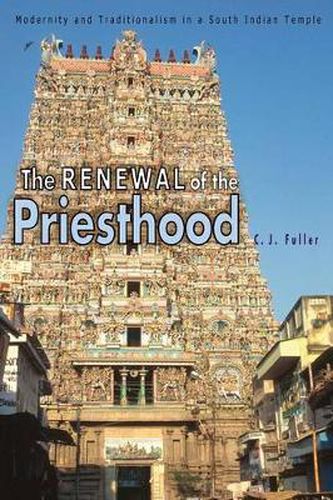Readings Newsletter
Become a Readings Member to make your shopping experience even easier.
Sign in or sign up for free!
You’re not far away from qualifying for FREE standard shipping within Australia
You’ve qualified for FREE standard shipping within Australia
The cart is loading…






Much has changed for the priests at the Minakshi Temple, one of the most famous Hindu temples in India. In The Renewal of the Priesthood , C. J. Fuller traces their improving fortunes over the past 25 years. This fluidly written book is unique in showing that traditionalism and modernity are actually reinforcing each other among these priests, a process in which the state has played a crucial role. Since the mid-1980s, growing urban affluence has seen more people spend more money on rituals in the Minakshi Temple, which is in the southern city of Madurai. The priests have thus become better-off, and some have also found new earnings opportunities in temples as far away as America. During the same period, due partly to growing Hindu nationalism in India, the Tamilnadu state government’s religious policies have become more favorable toward Hinduism and Brahman temple priests. More priests’ sons now study in religious schools where they learn authoritative Sanskrit ritual texts by heart, and overall educational standards have markedly improved. Fuller shows that the priests have become more ‘professional’ and modern-minded while also insisting on the legitimacy of tradition. He concludes by critiquing the analysis of modernity and tradition in social science. In showing how the priests are authentic representatives of modern India, this book tells a story whose significance extends far beyond the confines of the Minakshi Temple itself.
$9.00 standard shipping within Australia
FREE standard shipping within Australia for orders over $100.00
Express & International shipping calculated at checkout
Much has changed for the priests at the Minakshi Temple, one of the most famous Hindu temples in India. In The Renewal of the Priesthood , C. J. Fuller traces their improving fortunes over the past 25 years. This fluidly written book is unique in showing that traditionalism and modernity are actually reinforcing each other among these priests, a process in which the state has played a crucial role. Since the mid-1980s, growing urban affluence has seen more people spend more money on rituals in the Minakshi Temple, which is in the southern city of Madurai. The priests have thus become better-off, and some have also found new earnings opportunities in temples as far away as America. During the same period, due partly to growing Hindu nationalism in India, the Tamilnadu state government’s religious policies have become more favorable toward Hinduism and Brahman temple priests. More priests’ sons now study in religious schools where they learn authoritative Sanskrit ritual texts by heart, and overall educational standards have markedly improved. Fuller shows that the priests have become more ‘professional’ and modern-minded while also insisting on the legitimacy of tradition. He concludes by critiquing the analysis of modernity and tradition in social science. In showing how the priests are authentic representatives of modern India, this book tells a story whose significance extends far beyond the confines of the Minakshi Temple itself.